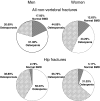Osteoporosis in men
- PMID: 18451258
- PMCID: PMC2528848
- DOI: 10.1210/er.2008-0002
Osteoporosis in men
Abstract
With the aging of the population, there is a growing recognition that osteoporosis and fractures in men are a significant public health problem, and both hip and vertebral fractures are associated with increased morbidity and mortality in men. Osteoporosis in men is a heterogeneous clinical entity: whereas most men experience bone loss with aging, some men develop osteoporosis at a relatively young age, often for unexplained reasons (idiopathic osteoporosis). Declining sex steroid levels and other hormonal changes likely contribute to age-related bone loss, as do impairments in osteoblast number and/or activity. Secondary causes of osteoporosis also play a significant role in pathogenesis. Although there is ongoing controversy regarding whether osteoporosis in men should be diagnosed based on female- or male-specific reference ranges (because some evidence indicates that the risk of fracture is similar in women and men for a given level of bone mineral density), a diagnosis of osteoporosis in men is generally made based on male-specific reference ranges. Treatment consists both of nonpharmacological (lifestyle factors, calcium and vitamin D supplementation) and pharmacological (most commonly bisphosphonates or PTH) approaches, with efficacy similar to that seen in women. Increasing awareness of osteoporosis in men among physicians and the lay public is critical for the prevention of fractures in our aging male population.
Figures











References
-
- Hannan MT, Felson DT, Dawson-Hughes B, Tucker KL, Cupples LA, Wilson PWF, Kiel DP 2000 Risk factors for longitudinal bone loss in elderly men and women: the Framingham osteoporosis study. J Bone Miner Res 15:710–720 - PubMed
-
- Melton LJ, Chrischilles EA, Cooper C, Lane AW, Riggs BL 1992 How many women have osteoporosis. J Bone Miner Res 7:1005–1010 - PubMed
-
- Forsen L, Sogaard AJ, Meyer HE, Edna T, Kopjar B 1999 Survival after hip fracture: short- and long-term excess mortality according to age and gender. Osteoporos Int 10:73–78 - PubMed
-
- Center JR, Nguyen TV, Schneider D, Sambrook PN, Eisman JA 1999 Mortality after all major types of osteoporotic fracture in men and women: an observational study. Lancet 353:878–882 - PubMed
Publication types
MeSH terms
Substances
Grants and funding
- AG027810/AG/NIA NIH HHS/United States
- P01 AG004875/AG/NIA NIH HHS/United States
- AR45647/AR/NIAMS NIH HHS/United States
- DE014386/DE/NIDCR NIH HHS/United States
- R01 AR027065/AR/NIAMS NIH HHS/United States
- HL070838/HL/NHLBI NIH HHS/United States
- R01 HL070838/HL/NHLBI NIH HHS/United States
- R01 AR049439/AR/NIAMS NIH HHS/United States
- RR024140/RR/NCRR NIH HHS/United States
- U01 AR045647/AR/NIAMS NIH HHS/United States
- AG004875/AG/NIA NIH HHS/United States
- AR049439/AR/NIAMS NIH HHS/United States
- R01 DE014386/DE/NIDCR NIH HHS/United States
- AR027065/AR/NIAMS NIH HHS/United States
- U01 AG027810/AG/NIA NIH HHS/United States
- UL1 RR024140/RR/NCRR NIH HHS/United States
LinkOut - more resources
Full Text Sources
Medical

